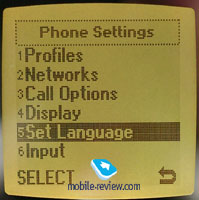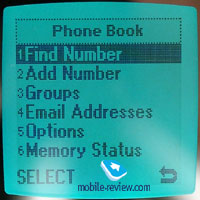Review Hyundai GX-100C

Hyundai
GX-100C, live pictures
Standard kit:
- Phone
- User's guide
- Charger
- Handsfree
Recently Hyundai started producing GSM phones, earlier
on this company was only well-known in Asia, as CDMA-terminals
manufacturer. Pantech’s acquisition of Hyundai’s mobile division
caused the appearance of new products. Pantach also bought
such company as Cruitel earlier on. GSM market was considered
as of the main vectors of company’s development. It may seem
rather strange, but almost all Asian phone producers invade
European market through Russia. One of the first models which
Hyundai had released, became a low-end clamshell phone GX-100C.

The phone has average size and a typical Asian design (silver
case). The exact size is (83x43x17,6 mm), it’s not big, nor
small. The phone has nice ergonomics, at least when the phone
is closed. Phone’s weight is 75 grams, which is typical for
this type of phone. The first peculiarity of the phone is
it’s antenna, it can be plugged out. You just have to pull
up the antenna’s top in order to plug it out. It’s typical
for CDMA-phones, but seems rather unusual for GSM ones. Actually
there’s no real affect on the network’s reception level, it’s
more like a psychological factor. We actually tested this
factor here in Moscow, and no differences between two antenna’s
positions were found. Most likely such move was made to please
the Asian consumers, who are used to such phones. There was
a time in USA, when phone producers were forced to make such
kind of antennas because the consumers didn’t believe that
the phone could actually work without one, and refused buying
it.

The external display is located on the upper panel. It’s
locked inside an eclipse frame. Screen’s resolution is 96x64
pixels, up to 2 text lines and two lines for icons can be
displayed at once. Everything is traditional, except for the
fact that the display’s backlight supports 8 colors. Considering
that this is a low-end phone – it’s a big advantage. It's
rather silly to demand external or internal color displays
now, such types of phones will appear only by the end of next
year, although first models will be available in the next
months.

Current time and basic indicators can be displayed on the
external screen, you can also place a screen saver that is
presented as analogue clock, and of course the backlight with
different colors.


Service LED is located near the antenna, it blinks with
green color. During the charging or talking it’s color will
be red. Volume control buttons are located on the left side
of the phone. There is a special button for external display’s
backlights activation. By the way, both external and internal
backlights are working at the same time, that’s because they
use the same LEDS. A headset connector is located on the upper
edge, meanwhile system connector is located on the phone’s
bottom, it’s covered with a rubber cork, which is connected
to phone’s case, so, you won’t lose it.

The clamshell can be opened by one hand, it’s rather convenient
when you have to answer an incoming call, like we have already
mentioned, there are several backlight’s colors:








Screens resolution is 120x104 pixels, it’s almost square.
On the other hand, because of oval edging of the screen, it
seems a bit stretched horizontally, which is not true. The
display supports four grey scale. The picture looks nice,
although the screen may flash when it encounters direct sunlight.
You can see a sun spot on many pictures, we tried to get rid
of it, and however it was useless. While you’re working with
the phone these flashes are unnoticeable, they aren’t bothering
or anything like that. Internal display can show up to 6 text
lines, the font is rather thick and reminds of the one used
in old Ericsson phones. to run a few steps forward, I will
tell you a secret, the phone is actually very similar with
old Ericsson phones, that’s because hardware part is from
Broadcom, and software part was most likely licensed from
a company which used to develop software part for Ericsson
phones (as far as I remember, it’s located in Great Britain,
although I don’t remember its title). A lot of factors lead
me to this conclusion, similarity of fonts, menu structure
and other minor things. Same technology is used by many Asian
producers, like Bird. But let’s get back to the phone, shall
we?
The keyboard is made of rubber with an exception for navigational
key, that is made of plastic. Keypad’s button size is average,
but they’re drowned into the case pretty much. Keyboards usage
comfortableness can be rated as average. It’s backlight is
blue, although it’s not spread equally, the brightest location
is near the navigational key, meanwhile other buttons look
a bit blurry. But this occurs only during complete darkness,
if you’re using the phone during the midday or in a room with
artificial lighting source – no problems will be noticed,
all symbols will be seen perfectly.

Back cover stores a battery inside it, Lithium-Polymeric
760 mAh type. Hyundai claims that the phone can work for about
200 hours in stand by mode, and up to 2 hours during the actual
talk. While we were testing this phone in Moscow, it worked
for about 3 days with 25 minutes spent for talks daily. It
takes slightly less than two hours for the phone to charge
up.

The last thing that has to be mentioned is the SIM-card
holder. It’s presented with special toddler. The holder has
two main problems, the first one is that it takes an effort
to move it, it’s just too tight, and the other one is extremely
unreliable fixation in end-position. So if you’re planning
exchanging your sim-card quite often – this phone will not
be suitable for you. Although, there is a high probability
that you will get used to it.

Menu
You can access the menu by pressing left soft-key. The
main menu is presented by the vertical list of items, fast
shorcut number navigation is supported. Sub-menus are presented
in the same well. Shortcuts can be assigned for keypad’s buttons,
and then you can access the menu item just by pressing one
button during the stand by mode. Menu seems logical and doesn’t
bring any difficulties during browsing. Localization is good
overall, however there are some minor peculiarities. The English
menu has title Bell for such settings, that are labeled as
Tone or Melody by other phone producers, for instance.



Call list. Lists of dialed/received/missed
calls; date and time can be viewed for every entry.
Phone settings. Profiles are located here,
they are standard, and no new features are introduced, you
can just personalize (ring tone, sms alert, vibrating alert,
etc) each profile for your needs. Display settings are located
here as well; you can choose backlight’s color and logos from
internal and external displays. Calendar, World Map, animation,
digital clock and day of week can be used as the external
screen’s logo.
You can also turn on/off service LED from this menu.
An interesting fact is that from this menu, and not from
the phonebook, you can assign custom backlight color to certain
entry of the phonebook. The feature seems to be rather interesting
and useful considering the number of available backlight’s
colors.
You won’t see anything special while choosing the appropriate
ring tone, only folder names and about 5-6 melodies in each.
Phonebook. 500 numbers can be stored in
phone’s memory, only one number can be assigned for each entry.
Groups are supported. You can also save up to 10 e-mail addresses.
Both SIM-card’s and phone book’s entries are shown in common
list. Fast search is present.



Messages. It takes quite a while (5-10
seconds, depending on the number of messages) for the phone
to open an SMS from SIM-card. Predictive text input, T9 is
supported, no other special features are available.

Accessories. The calendar is located here,
it can be displayed in Monthly mode. Here you can add not
only tasks, but set the time for warning about them as well.
This function is located right here, in the D-Days menu. It’s
hard to judge if such location is good or not.



The phone has an ordinary alarm clock, stopwatch with intermediate
results support, countdown, World Time function and a calculator.




Two games are available, Hell Fire (arcade, helicopter
flies and kills other helicopters), Stone Axe (you’re throwing
axes into barbarians). Games are not very fascinating, nor
addicting.


The phone has wap-browser 1.2.1. GPRS is not supported.
Impressions
Sound quality is nice; speaker transfers the interlocutor’s
voice clearly, without any annoying noises. No problems were
encountered during the testing period; the phone is competitive
in this term. Presence of pulling out antenna is just a psychological
factor, and it doesn’t have any real affect on the network
reception quality. Vibrating alert is slightly below average
level.

Manufacturer claims that GX-100C has 16-tone polyphonic
ring tones, however it doesn’t sound as well, as it’s competitors
with same amount of tones. The melodies sound too sonorous
and they get slightly distorted. In my opinion, we have 4
tones, not more. You can listen to the ring tone samples and
make up your mind.
Considering phones functionality, we can’t say that it
has the maximum amount of functions, more like a typical budget
model. People love clamshell phones that are why there will
be a certain amount of demand for Hyundai GX-100 C. Other
advantages of this phone are: nicely built case, interesting
design and various colors for displays backlight. The disadvantages
are: weak polyphonic ring tones, no GPRS support. Considering
that the phone costs about 160$ at the moment it can’t be
called optimal buy. The price will decrease in the nearest
future, and the phone will cost about 130$, which is more
interesting. In our opinion the price will still not be optimal,
the right one should be around 110-115 dollars. This price
is compiled by the phone’s function and image-part. Clamshells
are losing their exclusiveness and attractiveness, and are
turning into a typical phone in another variation at the moment.
Main competitors for this model is Philips 330, but with
the release of such phones as Motorola v150, Sagem myC-2 that
have color displays, attractiveness of Hyundai will certainly
fall down, unless the price will be decreased. That’s why
we predict huge price cut in February (about 100$), otherwise
the phone will simply disappear from the market. Paying 100
dollars for GX-100C makes it a good budget phone and worth
buying.
Ringtone
samples (270 Kb, mp3)
Eldar Murtazin (eldar@mobile-review.com)
Translated by Alexander "Lexx" Zavoloka(Lexx@i-5.delfi.lv)
Published — 24 December 2003
Have something to add?! Write us... eldar@mobile-review.com

































